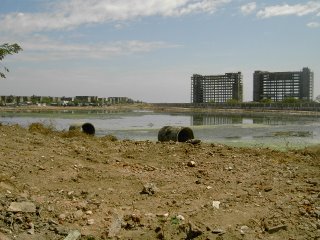According to a friend of mine who works closely with the fishermen in the city, the kuppam in Triplicane has an interesting story about their relationship with the
This makes sense. Even the
My blog has moved!
You should be automatically redirected in 5 seconds. If not, visit
http://theviewfromchennai.wordpress.com
and update your bookmarks.
One woman's thoughts on urban planning and urban life in a south Indian metropolis.
According to a friend of mine who works closely with the fishermen in the city, the kuppam in Triplicane has an interesting story about their relationship with the
This makes sense. Even the
The heat has settled like a woolen blanket over the city, and people are adjusting as best they can. Vendors line up wedges of watermelon under glass covers to keep out the flies. These and tender coconut water sell quickly. An institution trying to do a good deed in
It is also a time of temple festivals in
A few nights before that, I had gone out to dinner with a friend of mine. We were talking very late, till midnight, so he walked me home. As we turned into the area in front of the temple tank in Tiruvanmiyur, we saw a crowd under the large maidan where a band was playing. In the middle of the crowd was an enormous palanquin, on which was placed the decorated idol of Shiva, carried by a large group of young men. The idol was held facing the door of the temple. Two red flags flanked the palanquin with the sun and moon on them (Surya and Chandra), as well as two lamps. To our delight (we are both serious Bharata Natyam dancers), the idol danced! The palanquin bearers rocked the deity from side to side, while running back and forth on the maidan, the idol making a graceful zig zag. The lamps were moved up and down with the rocking and the flags were spun, horns were blown and drums were beaten, showing how the universe itself spun when Shiva danced.
More than the idol, I was mesmerized by the palanquin bearers who were intensely concentrated on their movements, at the degree of coordination needed in a group of that size in order to make the deity perform its intricate dance. Eight young men bearing Ambal’s palanquin ahead of Shiva did a pradakshanam around him, executing a kind of complex two step as they carried her. These men were closer to me, I could see their knitted brows, their profuse sweating, the order and beauty they carved as they progressed through the chaos of the crowds and smoke. These were obviously not priests, and because local people were involved with the rituals of the temple, this festival seemed to be much more concerned with reinforcing bonds of community, a kind of collective adoration of the god rather than the kind of individual awe invoked in bigger temples like the Brihadeeshwara in Tanjavur or in a cathedrals.
History, as I found in my reading, supports this intuition. The nadanam or dancing of the idol has been taking place in Tiruvanmiyur (thought to be at least 1,200 years old) and in a series of other temples in Tamil Nadu for hundreds of years. These boys who hold the palanquin were exercising hereditary rights to participate in temple rituals held by certain of the fishing communities in
One historian of
Unlike most poor communities in the cities, the largest slums of


I was later to find out that this visual drama is reflected in recent contentious history. In 2003, the community, along with other citizens’ groups in the city, fought against the Tamil Nadu government who wanted to build a Rs. 500 crore administrative and corporate complex along the beach. The beach, which was envisioned by one of the earliest governors in Madras Elihu Yale to be a “lung” for the city, was saved for the moment by the work of these groups. But the problem of eviction from their valuable beachside lands came up again in a different form a few years later.
On December 26, 2004, Srinivasapuram lost over 50 lives to the tsunami, as well as numerous homes and valuable property. As relief and rehabilitation became the stuff of daily news, Srinivaspuram residents were asked to leave their homes and move to temporary housing in Thoraipakkam, a strip of marshy land well inland. Some residents were intimidated into moving, but most refused and have stayed on in Srinivasapuram. Those who moved found that the temporary housing conditions were awful, tin huts that baked like ovens in the sun in an area that was far from any government services and sources of livelihood. Many have since returned. Residents and many of the groups working in Srinivasapuram felt that the temporary housing Thoraipakkam was part of a larger effort to move those residents of the beach who had the strongest claims to the land, the fishermen, away from their homes.
At their heart, questions of eviction in
I’ve been working regularly on my project, communicating with groups in Srinivasapuram and researching the history of slums, fishermen’s communities, and poverty in
Please check back frequently over the next three months, and please comment on the site. And wish me luck!